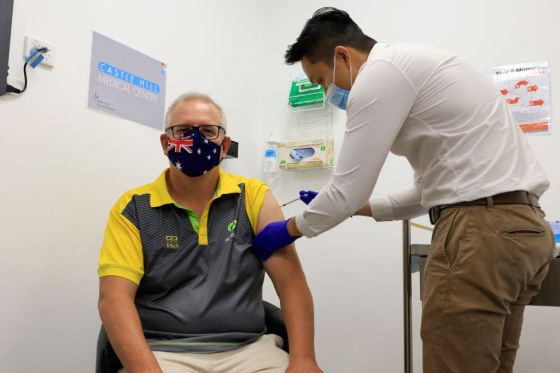New top story from Time: How Facebook’s Australia News Ban Could Hamper Vaccine Rollout to Aboriginal People
The COVID-19 vaccine rollout was never going to be easy in Australia’s sparsely populated, desert-covered Northern Territory. With many small towns located hours apart by road, organizers even considered using drones and dry ice to make deliveries.
But the vaccination campaign is facing an even greater uphill battle after Facebook removed news content across the country of 25 million on Feb. 18 following a battle over a bill that would force Big Tech companies to pay for the use of news stories. The ban also swept up Indigenous media organizations, meaning that Aboriginal people, who make up more than 25% of the region’s population may not have access to reliable information about vaccinations.
Many Aboriginal people rely on Facebook as a portal to the Internet. During the COVID-19 pandemic, Facebook has become “a primary vehicle for promoting health information to remote Aboriginal communities,” says Malarndirri McCarthy, a senator in the Northern Territory.
“The shut down of news sites on Facebook, and in particular First Nations news sites, is a dire situation for ensuring accurate information about the vaccine reaches First Nations communities,” says McCarthy, using a term that describes the people whose ancestors lived in Australia for tens of thousands of years before British colonization in the 18th century.
Aboriginal news outlets ‘outraged’
Numerous pages hosting important health and emergency information were also knocked offline by Facebook’s news ban, which blocks Australian news publications from hosting content, prohibits Australia’s 16 million Facebook users from sharing news links and stops people outside the country from sharing links to Australian news sites. Fire organizations—which provide important information during the country’s bushfire season, which is under way—charities, including food banks, and some state health department pages were also caught up in the sudden block. Many of these have since been restored.
Several Aboriginal community-run health services that were blocked appear to be back online. A representative for the Central Australian Aboriginal Congress (CAAC), an Aboriginal community-run health organization in the Northern Territory, tells TIME that its Facebook page was restored the evening after it had been blocked. NGO Danila Dilba Health Service, which also operates in the Northern Territory, says its Facebook was offline for about 12 hours.
Facebook said in a statement that pages like government, public safety, education and business pages that are not news should not be impacted, and that the company is working to restore them.
But Indigenous media outlets, like the popular broadcaster National Indigenous Television (NITV) and the only Indigenous radio service in Cairns, a city in the state of Queensland, are still unable to share news on Facebook.
Aboriginal media organizations say they are angered by the timing of Facebook’s move, and worried about the impact that it may have on vulnerable communities.
“We are outraged that access to First Nations voices has been limited in this way. Never has our media been more vital than during a global pandemic – especially on the cusp of vaccination rollouts,” Dot West, the chair of the advocacy group First Nations Media Australia, said in a statement.
Indigenous media organizations in remote areas have also expressed concern that they won’t be able to share vital information like flood warnings and telecommunications issues.
“There is a lot of fear surrounding the COVID-19 vaccine, we also live in a cyclone region so we are an emergency broadcaster. Our audience, our listeners rely on that easy access of Facebook to see those updates,” Tangiora Hinaki, the CEO of Ngaarda Media which operates in Western Australia, told NITV News.
The impact may be felt in other vulnerable communities too. Australian news is no longer shareable in the Pacific islands region, and Pacific news can’t be shared inside Australia, where more than 200,000 people with Pacific Islands ancestry live. Pacific Islanders also face an increased risk from COVID-19.
Vital news on vaccine rollout blocked
Prime Minister Scott Morrison received a vaccine on Feb. 21 and the country’s vaccination drive officially began on Feb. 22 for frontline healthcare workers, elderly nursing home residents and border control and quarantine staffers.

Vaccinations for Aboriginal people over the age of 55 (and other adults over the age of 70) will begin in the second phase of vaccinations which is scheduled for the end of March. Like many Indigenous groups around the world, Aboriginal people are more vulnerable to COVID-19, owing to a higher rate of other health issues and the difficulty of accessing medical care in the remote communities where some Aboriginal people live.
McCarthy says that Aboriginal people are avid consumers of social media, particularly Facebook. During the pandemic, Aboriginal media organizations, working with governments and community health organizations, have been crucial for getting information about the virus to remote communities, says McCarthy.
Videos translated into local languages to promote hand-washing, animations demonstrating the impact of lockdowns and local leaders sharing health messages have all been promoted by Indigenous media outlets on Facebook.
Misinformation could ‘dominate’ Facebook feeds
Australia’s Health Minister Greg Hunt has warned that Facebook’s actions could lead to misinformation from non-verified sources being further amplified.
Facebook tells TIME that it remains committed to combatting misinformation, and that it is working with governments to direct people to authoritative health information and notify them of new updates via its global COVID-19 Information Centre.
But as other content fills the gap left by news sources, misinformation may become increasingly problematic. This issue may be even more pronounced among Aboriginal communities, where trust in government and some institutions is low due to historical mistreatment.
“Urgent action is needed to ensure misinformation does not dominate people’s Facebook feeds,” warns McCarthy, “which is certainly a risk without trusted First Nations media organizations available on Facebook.”
Comments
Post a Comment